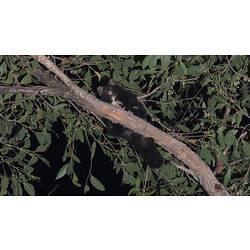General Description
Body fur long and shaggy. Fur colour above is quite variable and both sooty brown and pale white colours are common. The fluffy tail is longer than the combined head and body length. The ears are furry. A gliding membrane of skin stretches between the elbow and ankle. Body up to 45 cm, tail up to 60 cm. When spotted with a torch their eyes reflect a very bright white light.
Biology
Greater Gliders are the largest of the gliding marsupials, able to glide more than 100 m. Their tail acts as a rudder, steering the body. They nest in hollow spouts of tall trees, emerging at night to feed on eucalypt leaves and flower buds. The Greater Glider is relatively silent and rarely heard calling.
Distribution
Eastern mainland Australia.
Habitat
Forests and woodlands.
More Information
-
Animal Type
-
Animal SubType
-
Brief Id
A tree-dwelling, gliding marsupial with shaggy fur and a long furry tail.
-
Colours
Grey, White
-
Maximum Size
45 cm
-
Habitats
-
Where To Look
-
When Active
Nocturnal
-
Diet
Herbivore
-
Diet Categories
Eucalypt leaves
-
Endemicity
-
Commercial
No
-
Conservation Statuses
FFG Threatened List: Endangered, EPBC Act 1999: Vulnerable, CITES: Not listed, IUCN Red List: Vulnerable
-
Taxon Name
-
Common Name
Greater Glider
-
Kingdom
-
Phylum
-
Subphylum
-
Class
-
Superorder
-
Order
-
Suborder
-
Superfamily
-
Family
-
Subfamily
-
Genus
-
Species Name
volans




